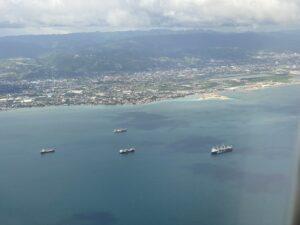
The second stop on my recent wildlife safari was Cebu Province in the Central Visayan region of the Philippines. From the air, the approach to Mactan Island reveals a sizable city and busy harbor. The name Mactan evolved from Mangatang, meaning pirate. Once upon a time, islanders preyed on passing ships. The pirates are long gone, but the name persists
THE CHOCOLATE HILLS

We came to visit the Tarsier Sanctuary at Corella on neighboring Bohol Island which is also the location of the famous Chocolate Hills. You’ve probably guessed the hills aren’t actually chocolate. They are karst formations of limestone. So how did they get their name? Some years back, an American tourist flew over the hills during the dry season when the vegetation dies off. The tourist said the hills resembled Hershey’s chocolate kisses, and the name stuck. We were there in the wet season, when the look a bit more like mints.
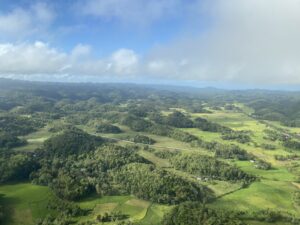
There are other stories associated with the hills. I like the one about Arogo, a powerful giant, who fell in love with a mortal named Aloya. When she died, Arogo was overcome by grief and endless weeping. When his tears dried, they became the Chocolate Hills.
PHILIPPINE TARSIERS
Tarsiers are primates that can fit in the palm of an adult hand, but they can’t bear the stress of being picked up. The Philippine tarsier is one of three types of tarsiers, and endemic to this region. The world population of Philippine Tarsiers is between 5-10,000, so they aren’t an endangered species yet. But their loss of habitat threatens their future. The animals got the name tarsier from their elongated ankle bone, also known as the tarsus.
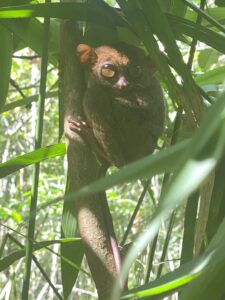
The tarsiers on Bohol are called Tarsus Carlito Syrichta in honor of Carolito “Lito” Pizarras, a man who became fascinated by the small creatures and through observation and self-education became an expert on tarsiers. He wasn’t always a defender of the species. Before developing an affinity for tarsiers, Pizarras captured and killed tarsiers and other animals for his father who was a taxidermist. At the time, a stuffed tarsier sold for about $5.00
Pizarras began to notice that he had to go deeper into the forest to catch tarsiers. By the 1970s, Pizarras stopped hunting tarsiers and began protecting them. Now he’s field supervisor at the Tarsier Sanctuary.
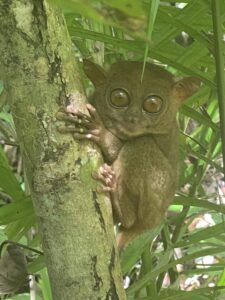
The tarsier is the world’s smallest primate, with a length between 3.5 and 6 inches, excluding the tail which is twice as long as its body. Particularly striking are the tarsiers’ large eyes; one eye can be larger than the creature’s brain. The eyes are fixed in their sockets and can’t move, but a tarsier can rotate his head 180 degrees.
Tarsiers are nocturnal and feed on insects they catch by jumping on them.
In the past people caught tarsiers and sold them as pets, but tarsiers refuse to live in captivity and commit suicide by banging their heads on the sides of cages or boxes. Capturing tarsiers is now illegal, which makes loss of habitat the greatest threat to tarsier survival.
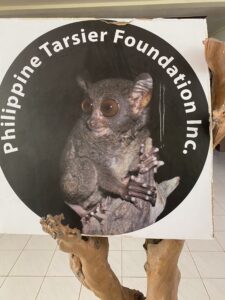
The Tarsier Sanctuary is part of the Philippine Tarsier Foundation, Inc. founded in 1996. The sanctuary covers 167 hectares.
After visiting the sanctuary, we were privileged to hear a performance by the Loboc Children’s Choir founded in 1980 by Alma Fernando-Taldo. The thirty singers between the ages of 9 and 13 attend Loboc Central Elementary School. They perform music in classical, folk, and modern styles and are three time national champions in the Philippine National Music Competition for Young Artists. Below is a video of a 2016 performance the choir did in Cambodia.
And in case you haven’t heard “I Love Cebu,” it’s a catchy tune.
Philippine Tarsier and Wildlife Sanctuary
“The Tarsier is More Sensitive Than You Know.” The Good Trip.
“Magnificent Chocolate Hills of Bohol.” Unusual Places.
Loboc Children’s Choir. Bohol.

Sandra Wagner-Wright holds the doctoral degree in history and taught women’s and global history at the University of Hawai`i. Sandra travels for her research, most recently to Salem, Massachusetts, the setting of her new Salem Stories series. She also enjoys traveling for new experiences. Recent trips include Antarctica and a river cruise on the Rhine from Amsterdam to Basel.
Sandra particularly likes writing about strong women who make a difference. She lives in Hilo, Hawai`i with her family and writes a blog relating to history, travel, and the idiosyncrasies of life.


Nice story on Bohol chocolate hills. And thanks for giving the information about TARSIERS species. Interesting blog.
Thank you. I’m glad you enjoyed the blog